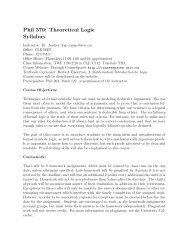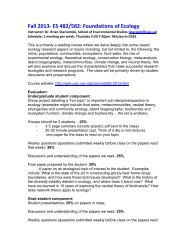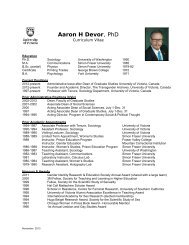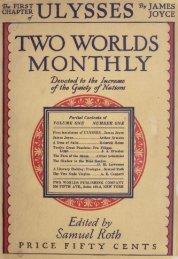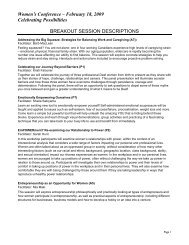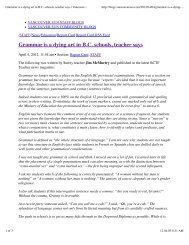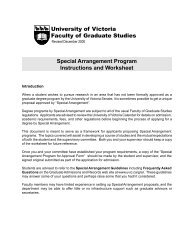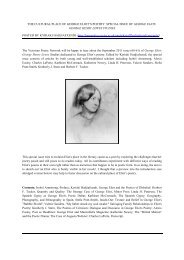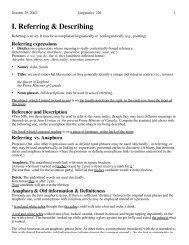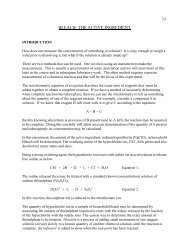Dynamic Life-Cycle Labour Supply
Dynamic Life-Cycle Labour Supply
Dynamic Life-Cycle Labour Supply
Create successful ePaper yourself
Turn your PDF publications into a flip-book with our unique Google optimized e-Paper software.
Topic 2.3b - <strong>Life</strong>-<strong>Cycle</strong> <strong>Labour</strong> <strong>Supply</strong><br />
Professor H.J. Schuetze<br />
Economics 371<br />
<strong>Life</strong>-cycle <strong>Labour</strong> <strong>Supply</strong><br />
The simple static labour supply model discussed<br />
so far has a number of short-comings<br />
For example example,<br />
The model does not allow for borrowing or saving<br />
i.e. does not account for the fact that individuals<br />
may be forward looking<br />
The model has been used to look at the economic<br />
determinants of labour supply (wages, (wages non-labour<br />
income etc.) but may not be as useful when looking<br />
at correlates such as age<br />
Professor Schuetze - Econ 370 2<br />
1
Stylized Facts<br />
To get a sense of what labour supply looks like over the life-cycle let’s<br />
look at participation rates by age for men and women, separately<br />
Cross Cross sections<br />
Different census years<br />
As we might expect, the<br />
participation profile for<br />
men is an inverted “U”<br />
Participation increases as men move into their 20’s<br />
Reaches a maximum in their early 30’s and remains<br />
there until their 50’s<br />
Declines as the conventional retirement age approaches<br />
Stylized Facts<br />
Professor Schuetze - Econ 370 3<br />
The age-participation<br />
profile for women has not<br />
been stable over time<br />
1971:<br />
Typical yp woman increased her labour supply pp y into her 20’s<br />
Reduced participation sharply (late 20’s early 30’s) likely<br />
to raise children<br />
Slight return to work in 40’s and 50’s until retirement<br />
Professor Schuetze - Econ 370 4<br />
2
Stylized Facts<br />
By 2001 women’s<br />
profiles began to look a lot<br />
like men’s, though with<br />
slower entry<br />
This suggests that we have to be careful to sort between<br />
life-cycle effects and cohort or year-of-birth effects<br />
The solid lines suggest that women born more recently<br />
have higher participation rates – early in the life-cycle<br />
�<br />
�<br />
Professor Schuetze - Econ 370 5<br />
<strong>Dynamic</strong> <strong>Life</strong>-<strong>Cycle</strong> <strong>Labour</strong> <strong>Supply</strong><br />
1.<br />
What explains these labour force patterns over<br />
the life-cycle?<br />
Clearly Clearly, some common life-cycle life cycle phenomena<br />
are important here:<br />
2.<br />
33.<br />
These patterns may also be explained by economic<br />
factors such as an individuals wage profile over<br />
the life-cycle<br />
Professor Schuetze - Econ 370 6<br />
3
<strong>Dynamic</strong> <strong>Life</strong>-<strong>Cycle</strong> <strong>Labour</strong> <strong>Supply</strong> Models<br />
To be certain, the simple static labour supply<br />
model is overly simplistic to determine what<br />
role these factors play<br />
Alternative models:<br />
1. Simply treat life-cycle labour supply as a<br />
sequence of static labour supply problems<br />
The individual simply maximizes utility in each<br />
period given the wage etc. in that period<br />
If the substitution effect > income effect<br />
Professor Schuetze - Econ 370 7<br />
<strong>Dynamic</strong> <strong>Life</strong>-<strong>Cycle</strong> <strong>Labour</strong> <strong>Supply</strong> Models<br />
Problem<br />
Examples:<br />
(a) If I know that next year’s wage is going to be<br />
really high I may react this year by working less<br />
(b) If I know that a decrease in my wage will only<br />
last a year, I may react differently than if the<br />
change were permanent<br />
Professor Schuetze - Econ 370 8<br />
4
<strong>Dynamic</strong> <strong>Life</strong>-<strong>Cycle</strong> <strong>Labour</strong> <strong>Supply</strong> Models<br />
2. <strong>Dynamic</strong> Framework<br />
The idea is that individuals make decisions<br />
about lifetime labour supply based on expected<br />
lifetime wages<br />
Assume the individual lives for N periods<br />
Individuals know wages etc. in the future with<br />
certainty (can relax this)<br />
Preferences: f<br />
Professor Schuetze - Econ 370 9<br />
<strong>Dynamic</strong> <strong>Life</strong>-<strong>Cycle</strong> <strong>Labour</strong> <strong>Supply</strong> Models<br />
Budget constraint:<br />
Assume that the price of consumption is<br />
constant (i.e. ( no inflation) )<br />
The individual knows wages in every period and<br />
has no non-labour income<br />
For a model with just 2 periods:<br />
This assumes that the interest rate equals q zero<br />
e.g. could consume everything in the first period<br />
C1 = w1•H1 + w2•H2 Consume next year’s earning this year without<br />
paying interest<br />
Professor Schuetze - Econ 370 10<br />
5
<strong>Dynamic</strong> <strong>Life</strong>-<strong>Cycle</strong> <strong>Labour</strong> <strong>Supply</strong> Models<br />
More realistic to assume that the individual<br />
can borrow and lend at interest rate (r)<br />
Recall that Ht=T-lt in any period (t)<br />
Thus, we can rewrite the budget constraint as:<br />
C2<br />
w2l2<br />
w2T<br />
C1<br />
+ + w1l1<br />
+ = w1T<br />
+<br />
( 1 + r ) ( 1 + r ) ( 1 + r )<br />
Comparative Statics<br />
Professor Schuetze - Econ 370 11<br />
The individual maximizes utility by choosing an<br />
optimal amount of consumption and leisure in<br />
each period<br />
Comparative Statics (income/substitution effects):<br />
Much more complicated than the static model<br />
Can illustrate some simple p comparative p statics to<br />
show the difference between the models<br />
It turns out that it matters whether the wage<br />
changes are permanent or transitory and<br />
anticipated or unanticipated<br />
Professor Schuetze - Econ 370 12<br />
6
Comparative Statics<br />
To help illustrate the differences between these let’s<br />
look at two hypothetical life-cycle earnings profiles<br />
w<br />
D Wages increase initially but may decline decline<br />
B<br />
C<br />
Jump at t is unanticipated wage change<br />
Allows us to look at 3 different sources of<br />
A<br />
wage change<br />
For comparison each has the same<br />
magnitude<br />
t Age<br />
1. A-B Permanent Unanticipated Wage Increase<br />
Comparative Statics<br />
Professor Schuetze - Econ 370 13<br />
Get typical income and substitution effects that<br />
work in opposite directions<br />
Income effect:<br />
Substitution effect:<br />
Overall effect:<br />
2. B-C Evolutionary Anticipated Wage Increase<br />
Professor Schuetze - Econ 370 14<br />
7
Comparative Statics<br />
Income effect:<br />
The income effect was already accounted for<br />
when the individual maximized utility<br />
Substitution effect:<br />
A worker that is forward looking will work more<br />
when the returns to work are highest<br />
Overall effect:<br />
The increase due to “intertemporal substitution”<br />
will be larger than a permanent unanticipated<br />
wage increase because there is no income effect<br />
Comparative Statics<br />
Professor Schuetze - Econ 370 15<br />
3. C-D Transitory, Unanticipated Wage Increase<br />
Could be unexpected overtime in one year<br />
Income effect:<br />
Thus, if leisure is normal, small reduction in work<br />
Substitution effect:<br />
Overall effect: The individual can afford to work slightly<br />
less over life-cycle but will likely work more at age t<br />
Professor Schuetze - Econ 370 16<br />
8
Comparative Statics<br />
The overall effect depends on whether the wage<br />
change is permanent or temporary and whether<br />
it is anticipated p or not<br />
The magnitude of the three effects examined<br />
here can be ranked as follows:<br />
B-C<br />
C-D<br />
A-B<br />
Fertility and Child Bearing<br />
Professor Schuetze - Econ 370 17<br />
From our earlier diagram it is clear that fertility<br />
decisions play an important role in the life-cycle<br />
labour supply of women<br />
Recent analyses of the fertility decision are cast<br />
in a dynamic setting much like the previous<br />
model<br />
This is because decisions about fertility today<br />
will impact p future economic factors such as<br />
future wages<br />
We will examine some of the simpler aspects of<br />
the fertility decision<br />
Professor Schuetze - Econ 370 18<br />
9
Becker/Mincer Model<br />
Apply the principles of consumer demand theory<br />
to the decision to have children<br />
Think of children as a “good” that is “consumed”<br />
Difficult to think of children this way?<br />
It is argued that individuals respond to<br />
economic factors when making fertility decisions<br />
Examples:<br />
11.<br />
2.<br />
Factors Influencing Fertility<br />
Professor Schuetze - Econ 370 19<br />
If we view children as consumer goods what<br />
factors influence the fertility decision?<br />
Income:<br />
Ceteris paribus effect of an increase in income<br />
will be an increase in the desired number of<br />
children if children are “normal goods”<br />
Cost of Children:<br />
Professor Schuetze - Econ 370 20<br />
10
Factors Influencing Fertility<br />
Economic theory suggests that the demand for<br />
children will be negatively related to the cost<br />
However However, an increase in the potential income of<br />
wives (opportunity cost) has both income and<br />
substitution effects<br />
Substitution effect:<br />
Income effect:<br />
Factors Influencing Fertility<br />
Professor Schuetze - Econ 370 21<br />
Price of Related Goods:<br />
Increase in the price of complements such as<br />
day care and education will reduce the desired<br />
number of children<br />
Tastes and Preferences:<br />
Family planning and women’s liberation<br />
movement have likely led to smaller family sizes<br />
Economists usually view tastes as exogenous<br />
It is, however, possible that tastes help to shape<br />
and are shaped by the economic environment<br />
Professor Schuetze - Econ 370 22<br />
11
Factors Influencing Fertility<br />
e.g.<br />
Technology:<br />
The introduction of “the pill” and other<br />
contraceptive devices likely reduced family size<br />
Others such as fertility drugs may help to<br />
increase family family size<br />
Retirement<br />
Professor Schuetze - Econ 370 23<br />
Decision by older persons not to participate in<br />
the labour force<br />
In Canada there has been a trend towards<br />
early retirement<br />
Participation rates of individuals aged 55+ have<br />
fallen substantially:<br />
Thus, the retirement decision and its impact<br />
hhave received i d an enormous amount t of f<br />
attention by researchers<br />
Professor Schuetze - Econ 370 24<br />
12
Retirement<br />
Given its importance and the fact that the<br />
government has many “tools” that affect retirement<br />
it’s it s no surprise it attracts so much attention.<br />
� “Tools” -<br />
-<br />
We will examine the retirement decision as follows:<br />
1. Restating income-leisure model<br />
2. Possible determinants<br />
mandatory retirement retirement<br />
wealth and earnings<br />
wealth and nature of work and family<br />
pension system<br />
3. Empirical evidence<br />
Professor Schuetze - Econ 370 25<br />
Income-Leisure Choice Model Restated<br />
($)<br />
Y0<br />
Could substitute years of retirement for leisure<br />
on the x-axis and use our model for analysis.<br />
l 0<br />
T<br />
U 0<br />
Years of<br />
Retirement<br />
Let T be the number of years<br />
until death minus say 25<br />
� supposing start work at<br />
25 and can work that<br />
long<br />
Professor Schuetze - Econ 370 26<br />
13
Income-Leisure Choice Model Restated<br />
wE is now the “expected” wage (different than<br />
going wage)<br />
The expected wage may be influenced influenced by<br />
�<br />
�<br />
Also note, that individuals preferences for work<br />
may change over a lifetime -<br />
Possible Determinants<br />
1. Mandatory Retirement<br />
Refers to either:<br />
Automatic Retirement:<br />
Compulsory Retirement:<br />
Professor Schuetze - Econ 370 27<br />
Note: No legislated age at which individuals must<br />
retire<br />
age is set by employer policy or negotiated in a<br />
collective agreement<br />
public pensions do not prevent individuals from<br />
working<br />
Professor Schuetze - Econ 370 28<br />
14
Mandatory Retirement<br />
How does mandatory retirement affect the<br />
decision to retire?<br />
Y($)<br />
→ Start age 25<br />
→ Die age 90<br />
→ 65 years work possible<br />
Y 0<br />
E 0<br />
l 0<br />
(20)<br />
E 1<br />
MR<br />
(25)<br />
T<br />
(65)<br />
Years of<br />
Retirement<br />
→Would like to choose point like E0 • 20 years of leisure<br />
• work (65-20=45) years to age 70<br />
→ Suppose agreement to retire at 65<br />
Mandatory retirement means you must retire at 65 → take 25<br />
years of retirement<br />
�<br />
Wealth and Earnings<br />
Professor Schuetze - Econ 370 29<br />
2. Wealth and Earnings<br />
Wealth: savings, investment values, etc.<br />
What will happen if wealth increases increases (receive a<br />
bequest)?<br />
I-L model predicts that one would retire earlier<br />
(choose more leisure)<br />
Why?<br />
Professor Schuetze - Econ 370 30<br />
15
Earnings<br />
Earnings: flow of funds<br />
What will happen if expected earnings increase?<br />
Has both income and substitution effects<br />
Opportunity cost of retiring goes up --<br />
Real wealth rises --<br />
Health and Nature of Work<br />
Professor Schuetze - Econ 370 31<br />
3. Health and the Nature of Work and Family<br />
Health:<br />
As people age their health can influence the<br />
retirement decision.<br />
Less likely to continue working if you or your<br />
spouse is unhealthy.<br />
Nature of Work:<br />
If you have a physically demanding job you may be<br />
more likely to retire early.<br />
Doesn’t explain increase in early retirement as<br />
there has been an increase in “white collar” jobs<br />
over the harder “blue collar” jobs.<br />
Professor Schuetze - Econ 370 32<br />
16
Family<br />
Family:<br />
Decline of extended family suggests individuals<br />
should retire later (less support)<br />
However, there has been an increase in two earner<br />
families which may lead to earlier retirement (more<br />
wealth)<br />
Most of these affect the shape of the individuals<br />
iindifference diff curve.<br />
Professor Schuetze - Econ 370 33<br />
Example: Changes in Tastes for Work<br />
As you get older preferences for leisure tend to increase (job<br />
becomes more difficult).<br />
($)<br />
Y 0<br />
E 0<br />
l T Years of<br />
0 l T Years of<br />
Retirement<br />
0<br />
Initially at E0 With age you become more willing to consume leisure<br />
Now better off at E1 U 0<br />
Professor Schuetze - Econ 370 34<br />
17
Pensions<br />
4. Pension System<br />
The generosity of public and private pensions is the<br />
most likely cause of the increase in early retirement.<br />
Canada’s pension system has three tiers<br />
I. Universal Old Age Security Pension:<br />
Unconditional grant given to all persons over the age<br />
of 65<br />
The Guaranteed Income Supplement (GIS):<br />
A means tested pension which can be paid to those<br />
over age 65<br />
Pensions<br />
Professor Schuetze - Econ 370 35<br />
If you qualify for GIS and work then your earnings are<br />
taxed back at a rate of 50%<br />
II. Social Insurance Pensions (CPP/QPP)<br />
Financed by compulsory employer and employee<br />
contributions (payroll tax).<br />
Qualify by age and work experience.<br />
Pay out based on past earnings.<br />
United States social security has a “retirement test”<br />
� receive full pension as long as income is less than<br />
threshold ($17,000 in 2000)<br />
� income above threshold is taxed back at a rate of 33%<br />
Professor Schuetze - Econ 370 36<br />
18
Social Security<br />
$47,000<br />
$27,000<br />
$10,000<br />
E Get full benefits (B) upon<br />
D<br />
retiring<br />
l T Years of<br />
Retirement<br />
D lc C<br />
Can work (T - l<br />
B<br />
c ) hours<br />
without being taxed<br />
B - C is parallel to initial<br />
constraint.<br />
Beyond l c , taxed back at 33%.<br />
C - D wage is lower.<br />
At D all retirement income is taxed back.<br />
Back on original income constraint.<br />
Effects of Pension Plan<br />
Professor Schuetze - Econ 370 37<br />
Income Effect:<br />
Increased income with OAS with which to purchase<br />
leisure (retire earlier)<br />
Substitution Effect:<br />
The opportunity cost of leisure is either the same as<br />
before (B - C) or less (C - D)<br />
Professor Schuetze - Econ 370 38<br />
19
Employer Sponsored Pensions<br />
Employer Sponsored Pension Plan:<br />
3 types - based on how benefits are calculated<br />
11. Earnings Earnings Based (most common)<br />
Pension based on:<br />
Length of service<br />
Earnings in either<br />
(a) Final years<br />
e.g. 2% of average earnings in final 3 years for each year of<br />
service up to 35 years<br />
i.e. 70% replacement rate<br />
(b) Average over career<br />
Professor Schuetze - Econ 370 39<br />
Employer Sponsored Pensions<br />
2. Flat Benefit<br />
Receive a fixed benefit for each year of service<br />
ee.g. g $20 $20 per month per year of service to a maximum of 35<br />
years → $700 per month.<br />
3. Defined Contribution (covers fewest)<br />
Benefits are equal to the value of contributions made<br />
by the employee or employer<br />
1 and 2 are so-called “defined benefits” plans<br />
because the benefits are defined at the outset<br />
The plans influence retirement decisions because of:<br />
�<br />
�<br />
Professor Schuetze - Econ 370 40<br />
20
Empirical Evidence<br />
2 types of studies<br />
(i) Survey Interviews - ask why retired<br />
(ii) labour force participation studies - statistical<br />
The two give conflicting answers as to what affects<br />
retirement decisions.<br />
Survey:<br />
May be biased:<br />
Empirical Evidence<br />
Professor Schuetze - Econ 370 41<br />
Statistical:<br />
Social insurance pensions have effect on retirement.<br />
Ill health also has an effect especially if a pension is<br />
available.<br />
Employer sponsored plans have the expected effect<br />
also<br />
�<br />
�<br />
Professor Schuetze - Econ 370 42<br />
21



